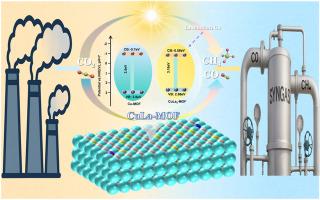CuLa双金属金属有机骨架的构建及其光催化CO2转化为CO的增强性能
IF 4.9
3区 材料科学
Q2 CHEMISTRY, MULTIDISCIPLINARY
引用次数: 0
摘要
随着温室气体排放对环境的威胁日益加剧,如何将CO2有效转化为高价值化工产品(如CO、CH4)已成为研究热点。因此,掺杂策略,特别是稀土元素的掺入,已被证明在优化光催化剂的电子结构和调节反应途径方面是有效的。本研究采用溶剂热法成功合成了镧(La)掺杂铜基金属有机骨架(Cu-MOFs)。在光催化CO2还原过程中,氧空位与La-Cu双活性位点之间的协同作用显著增强了CO2吸附、光吸收效率和载流子分离。实验结果表明,CuLa3-MOF具有优异的CO选择性(99.96%)和光催化性能,CO产率为163.69 μmol g−1h−1,是未掺杂Cu-MOF (21.58 μmol g−1h−1)的7.58倍。该研究为开发有效的CO2利用光催化剂提供了新的见解,并突出了稀土元素在增强催化体系中的重要作用。本文章由计算机程序翻译,如有差异,请以英文原文为准。

Construction of CuLa bimetallic metal-organic frameworks and their enhanced performance for photocatalytic conversion of CO2 to CO
With the escalating threat of greenhouse gas emissions to the environment, the effective transformation of CO2 into high-value chemical products (e.g., CO, CH4) has become a major focus of research. Consequently, doping strategies, particularly the incorporation of rare-earth elements, have proven effective in optimizing the electronic structure of photocatalysts and modulating reaction pathways. In this study, lanthanum (La)-doped copper-based metal-organic frameworks (Cu-MOFs) were successfully synthesized using a solvothermal method. During the photocatalytic CO2 reduction process, the synergistic effect between oxygen vacancies and La–Cu dual active sites significantly enhanced CO2 adsorption, light absorption efficiency, and charge carrier separation. Experimental results demonstrated that CuLa3-MOF exhibited excellent CO selectivity (99.96 %) and photocatalytic performance, achieving a CO yield of 163.69 μmol g−1h−1, which is 7.58 times higher than that of undoped Cu-MOF (21.58 μmol g−1h−1). This research provides new insights into the development of effective photocatalysts for CO2 utilization and highlights the crucial role of rare-earth elements in enhancing catalytic systems.
求助全文
通过发布文献求助,成功后即可免费获取论文全文。
去求助
来源期刊
CiteScore
7.80
自引率
2.50%
发文量
605
审稿时长
40 days
期刊介绍:
The Journal of Physics and Chemistry of Solids is a well-established international medium for publication of archival research in condensed matter and materials sciences. Areas of interest broadly include experimental and theoretical research on electronic, magnetic, spectroscopic and structural properties as well as the statistical mechanics and thermodynamics of materials. The focus is on gaining physical and chemical insight into the properties and potential applications of condensed matter systems.
Within the broad scope of the journal, beyond regular contributions, the editors have identified submissions in the following areas of physics and chemistry of solids to be of special current interest to the journal:
Low-dimensional systems
Exotic states of quantum electron matter including topological phases
Energy conversion and storage
Interfaces, nanoparticles and catalysts.

 求助内容:
求助内容: 应助结果提醒方式:
应助结果提醒方式:


